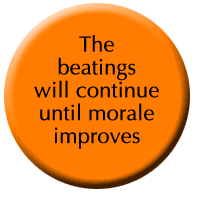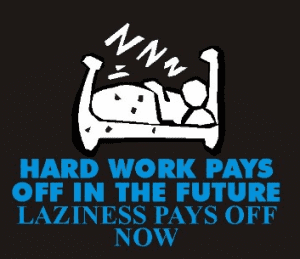 Welcome to part eight of the Nine Dangerous Mindsets series. In this installment I’m going to take on one of the most challenging and perhaps one of the most frustrating mindsets – the Slacker. This mindset is dangerous to situational awareness because a Slacker does so little to ensure his or her personal readiness for the high risk, low frequency tasks that can kill first responders. This article explores the origins of the slacker and makes some recommendations for how to work through this challenge.
Welcome to part eight of the Nine Dangerous Mindsets series. In this installment I’m going to take on one of the most challenging and perhaps one of the most frustrating mindsets – the Slacker. This mindset is dangerous to situational awareness because a Slacker does so little to ensure his or her personal readiness for the high risk, low frequency tasks that can kill first responders. This article explores the origins of the slacker and makes some recommendations for how to work through this challenge.
The Slacker
 Slacker (noun): A person who avoids work or effort. I think we all knew that already. The slacker does the least amount of work possible to remain employed. They are a minimal contributor and seem to be content in their mediocrity. Getting them to get enthusiastic about work is like trying to get a lazy dog to fetch a stick. Or, less generously, it’s like trying to teach a pig to sing. You’re not going to succeed and you’re only going to annoy the pig.
Slacker (noun): A person who avoids work or effort. I think we all knew that already. The slacker does the least amount of work possible to remain employed. They are a minimal contributor and seem to be content in their mediocrity. Getting them to get enthusiastic about work is like trying to get a lazy dog to fetch a stick. Or, less generously, it’s like trying to teach a pig to sing. You’re not going to succeed and you’re only going to annoy the pig.
The Origins
I’d like to think that an organization does not set out to have slackers and, hopefully, has some mechanisms in place during the hiring process to hire non-slackers. If slackers are hired into the organization from the start, then shame on the leadership for failing to fix the root cause of the problem (hiring practices). But, let’s assume for a moment that an organization goes to great lengths to hire bright, enthusiastic and motivated recruits. And further, let’s assume the organization is successful in hiring high performing employees. If that’s the case, where do the slackers come from?
If the organization hires good people, the slackers are made from within the organization. But how? One way might be the influence of slacker peers or slacker supervisors. But if the organization hires only high performing employees and if we can assume it promotes on the same premise, then where do these slacking peers and supervisors come from? You got it. They are made from within the organization.
Beat Down

 I once saw a bumper sticker that said “The beatings will continue until the morale improves.” I had to laugh at the irony contained within that statement and how it juxtapositions the contrasting notion that an employer can use discipline to improve an organization. The employees I have spoken to who are Slackers didn’t start that way. They were created through repetitive exposure to poor leaders who berated them and demoralized them.
I once saw a bumper sticker that said “The beatings will continue until the morale improves.” I had to laugh at the irony contained within that statement and how it juxtapositions the contrasting notion that an employer can use discipline to improve an organization. The employees I have spoken to who are Slackers didn’t start that way. They were created through repetitive exposure to poor leaders who berated them and demoralized them.
Eventually, like a dog who is beaten repetitively, they withdraw and realize it is better to do nothing, as doing nothing results in the same, or sometimes less, consequences than trying to make a difference. “What’s the use?” becomes their mantra.
Complacent
A Slacker can also be a victim of complacency. If a Slacker finds a shortcut or performs his or her work with less than maximum effort and has no consequence, this can actually serve as a positive reinforcement that the job can actually be accomplished with less effort or in a short way. No one is there to hold the Slacker accountable and the slacking becomes a norm – an acceptable reduction in effort with a perception the outcome is the same (or even better… less effort). It may be difficult to convince a chronically complacent individual that their behavioral norm has a flaw. After all, if there’s been no consequence up to this point, what’s the likelihood there’s going to be one now?
Frustration
 Slackers create frustration because they seem to be so indifferent to their plight. They may even seem indifferent to your safety. And worst of all, they may seem indifferent to their own safety. It almost defies logic that a person would become so lazy that they would jeopardize their own safety. But it’s doubtful they see it that way. They see their slacking as a strategy that works and the results are favorable. After all, they’re putting in far less effort than you, not sweating the details of their work at all. In fact, literal sweat has probably not dampened their brow in quite some time. And they get the same paycheck as you regardless of their minimal efforts. So who’s the fool?
Slackers create frustration because they seem to be so indifferent to their plight. They may even seem indifferent to your safety. And worst of all, they may seem indifferent to their own safety. It almost defies logic that a person would become so lazy that they would jeopardize their own safety. But it’s doubtful they see it that way. They see their slacking as a strategy that works and the results are favorable. After all, they’re putting in far less effort than you, not sweating the details of their work at all. In fact, literal sweat has probably not dampened their brow in quite some time. And they get the same paycheck as you regardless of their minimal efforts. So who’s the fool?
Dangerous
 The Slacker is dangerous because they have become indifferent to the deterioration of their skills. If the only person they could harm were themselves, then it might not be nearly as bad. But in the high risk, low frequency, dynamically changing environments that first responders operate in, no one operates in a vacuum. The performance of the team is only as strong as the weakest link and a Slacker is a weak link.
The Slacker is dangerous because they have become indifferent to the deterioration of their skills. If the only person they could harm were themselves, then it might not be nearly as bad. But in the high risk, low frequency, dynamically changing environments that first responders operate in, no one operates in a vacuum. The performance of the team is only as strong as the weakest link and a Slacker is a weak link.
Dr. Gasaway’s Advice
 Something, or better yet, someone, got them into this state. Someone hurt them along the way and their pain and fear is causing them to avoid taking risks. This is going to sound bizarre as hell when I suggest this and, quite frankly, I’m not sure if I’d blame you for thinking I’m a kook for suggesting it, but here goes. Apologize.
Something, or better yet, someone, got them into this state. Someone hurt them along the way and their pain and fear is causing them to avoid taking risks. This is going to sound bizarre as hell when I suggest this and, quite frankly, I’m not sure if I’d blame you for thinking I’m a kook for suggesting it, but here goes. Apologize.
What!?! (I can almost hear you screaming from here). Apologize? For what? You didn’t do anything wrong! In nearly all cases, that will be true. You did not create the problem. But you’re sure being affected by it (don’t deny it… it eats at you like termites gnaw on fresh wood). But if you didn’t do anything wrong, why would I recommend you apologize?
Because they’re hurt and they need to hear someone say they’re sorry for how they have been made to feel (angry, resentful, hurt). Assuming you are not the one who created this mess, the apology can be an indirect apology. What? You cannot apologize for the mess you did not create, but you can regret that it happened.
Get them to talk with you about why they give so little effort (but don’t be confrontational). If you can get them to open up, they’re going to tell you why they are hurt and angry and who’s to blame. Then you say: “I can understand why you feel this way. I regret that happened to you. I am sorry. What can I do to help make it right.” Chances are they’ll say there’s nothing you can do, but give them the chance to say if there is.
Then, ask them for help. Tell them you’re afraid of getting hurt because the team needs to be strong and you need them to help you ensure the team is strong. Chances are, no one has talked to them with such compassion for a very, very long time. Depending on how hardened their heart has become, they may not be willing to get on-board right away. Give them a little time and space if that’s the case. You can’t rush the healing of a wound. Sometimes it takes time. But you can keep caring for the wounded by showing them you are genuinely concerned and want them to help strengthen the team.
You have nothing to lose and everything to gain from making the effort to light the fire in a Slacker. Well, as I reflect on that last sentence, I guess in reality you have A LOT to lose if their slacking results in you becoming a casualty.
Action Items
 1. Discuss the factors that could contribute to a high performing employee becoming a slacker. The key to helping them is to first understand them.
1. Discuss the factors that could contribute to a high performing employee becoming a slacker. The key to helping them is to first understand them.
2. Discuss non-punitive strategies for how to get a slacker to engage. Avoid threats, fear, ridicule, embarrassment, and consequence as your motivators. They’re not going to work, at least long term.
3. Imagine you were a teacher trying to reach a child who was a slacker in school but you knew it was a direct result of an abusive home environment. What techniques (short of having protective services or the police intervene at home) could you use to improve the performance of the the troubled child. When you begin to see the Slacker as a victim, you take on new compassion and approaches to solutions.
_____________________________________________________

If you are interested in taking your understanding of situational awareness and high-risk decision making to a higher level, check out the Situational Awareness Matters Online Academy.
CLICK HERE for details, enrollment options and pricing.
__________________________________
Share your comments on this article in the “Leave a Reply” box below. If you want to send me incident pictures, videos or have an idea you’d like me to research and write about, contact me. I really enjoy getting feedback and supportive messages from fellow first responders. It gives me the energy to work harder for you.
Thanks,

Email: Support@RichGasaway.com
Phone: 612-548-4424
SAMatters Online Academy
Facebook Fan Page: www.facebook.com/SAMatters
Twitter: @SAMatters
LinkedIn: Rich Gasaway
Instagram: sa_matters
YouTube: SAMattersTV
iTunes: SAMatters Radio
iHeart Radio: SAMatters Radio

Fascinating article, some great advice there.
Thanks Derek.
Wow, Amazing great article ! oh man, that sentence : “Eventually, like a dog who is beaten repetitively, they withdraw and realize it is better to do nothing, as doing nothing results in the same, or sometimes less, consequences than trying to make a difference. “What’s the use?” becomes their mantra.”
I could not have stated it better. After years of various ‘usual’ abuse in corporate environments (the burnout toxic one where you work like a slave ; the boreout toxic one where you get too few work ; the bipolar intimidating boss harassing people ; the depressed short-tempered sabotaging boss ; the incompetent overinflated young manager ; lack of recognition ; etc.), I gradually moved from the overmotivated employee (my fault) to the thriving slacker (my responsibilty).
My today manager is soon to be retired. No real tasks to complete for several months now. And I really don’t care anymore. what for ?
So long studies at university ; so much hard work and sacrifices ; so few results , so many disappointments, struggles, hurt, and disillusionement. Life’s short, make up your agenda, take the paycheck and let’s celebrate real life freedom ! 🙂